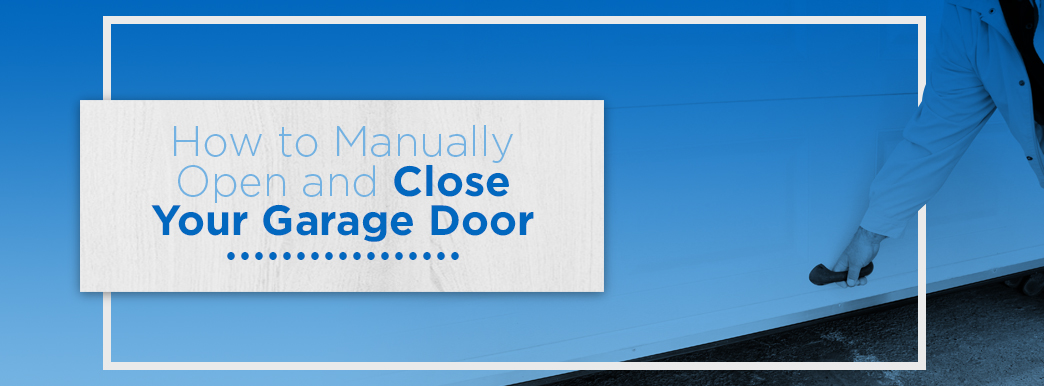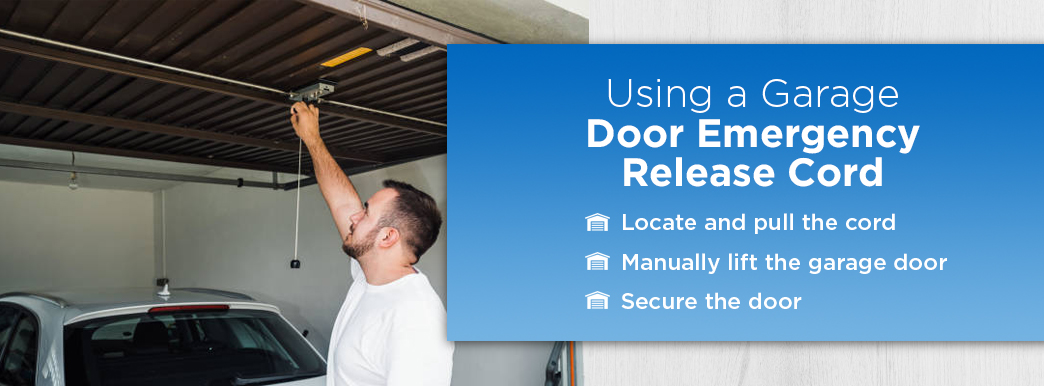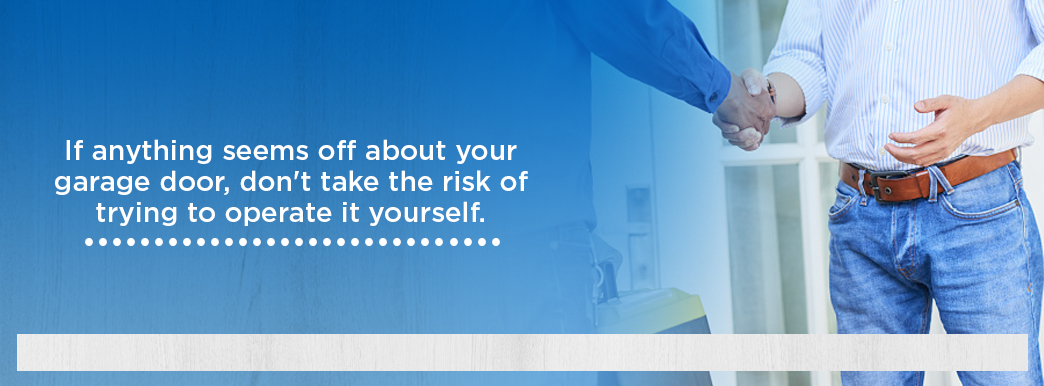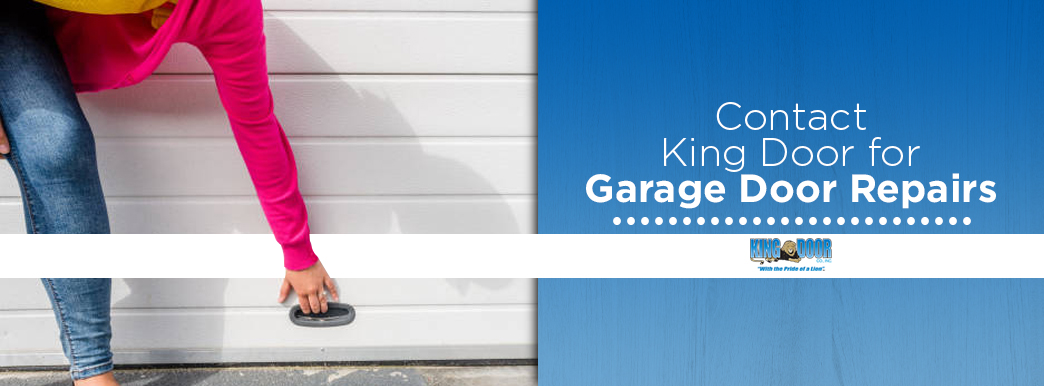Your automatic garage door provides you with convenience and protection. But what happens if you can’t open your door automatically? You don’t need to feel like you’re shut out from your garage. If you know how to manually open and close a garage door, you can save yourself the hassle of dealing with a door that won’t open and the security risk of a door that won’t shut.
Need Help? Contact King Door Now
Manually lifting your garage door can solve some issues, but you should troubleshoot your situation first. Trying to manually open a garage door that is damaged can cause more damage to the door and puts you and others at risk of injury. If you’re having trouble opening your garage door, you may have:
- A broken spring
- Broken or loose door cables
- A door that has dislodged off its track
- Experienced a power outage
- A malfunctioning garage door remote
You will need to manually lift your garage door if you have experienced the last two reasons for a malfunctioning door. Any loss of power to an automatic door and any technical issues with a remote mean you’ll have to open your garage door manually. You could also have to lift the door manually in an emergency where sensors malfunction and you need to lift the door off something. In non-emergency situations, you may simply want to disengage your garage door opener when you’re going away on vacation. No matter your reason, you’ll want to know how to manually open your garage door by detaching the automatic opener.
Using a Garage Door Emergency Release Cord
You aren’t out of luck if you can’t get your garage door to open at the push of a button. Garage doors come with an emergency release cord to use in the above situations. The cord allows you to disengage your garage door from the opener, allowing you to open it manually. The garage door manual open emergency release cord is usually a red rope with a red pull handle, and you will find it on the opener rail near your door. To use the cord, follow these steps:
- Locate and pull the cord: Holding the handle at the end of the cord, pull until the release lever locks. Pulling the cord detaches the garage door from the opener and allows it to open manually. Typically, you have to pull the cord straight down or slightly away from the door to disengage the opener. Since the lever is spring-loaded, you will have to pull with enough force to lock it into place.
- Manually lift the garage door: Using both hands and help from others if you need it, raise the garage door. If you cannot open it, check that you’ve correctly detached the lever and try again. Do not try to force the door open if there is resistance. Forcing the door could lead to injury, and it may be a sign that your door is damaged.
- Secure the door: Be sure not to let go of the door until it is secure. Springs on your garage door may hold it in place, so it should stay open on its own when you manually operate it. Your door may have defective springs or another issue if it can’t stay open. While you can prop it open or have others hold it long enough to take your car or other items out of the garage, you should contact a professional and avoid operating your door if you notice any issues.
While opening your garage door manually is straightforward with the steps above, you should still proceed carefully. When you have to use the emergency release cord of your garage door, use caution and remember these warnings:
- If you’re releasing an open door, clear the area in case the door closes suddenly
- Try to ensure that the garage door is closed before you work with the door in any way
- Have others help you if you can’t lift the weight of a closed door
- Prop open the door with something sturdy or have others hold the door if it doesn’t stay open on its own
After manually opening and closing your garage door, remember to lock it manually if you’re leaving. The manual lock allows you to secure your garage door and everything in your garage, even in a power outage. Remember to unlock it before trying to open it again, manually or automatically. Check that the door’s manual lock is not in use if you’re having trouble opening your garage door.
Once you’ve used the emergency release cord of your garage door, you’ll have to ensure that you can use your automatic opener again. To do this, you should know how to reattach the garage door opener.
Re-Engaging Your Garage Door Opener After Using the Emergency Release Cord
Since pulling the emergency release cord disengages your garage door opener for manual operation, you’ll have to re-engage it if you’d like to use your automatic opener. Get that convenience back by learning how to reattach your garage door opener. Whether you need to re-engage a LiftMaster garage door opener or another brand, follow these steps:
- Be sure the door is closed: Your door needs to be closed before you can reset your garage door after a power outage. If it’s open, you risk having the garage door crash down, which puts you and others at risk for injury. The force of the garage door closing may also break the door, any glass windows in it or the structure of your garage itself.
- Try pressing the appropriate buttons: Push the open button on your garage door remote, then press the close button if your remote has separate buttons for opening and closing. Your garage mechanism may reattach itself. If the remote doesn’t work, try the next step.
- Manually open LiftMaster garage door: You can manually slide the door along the track if your power is still out or your remote doesn’t work. With either this or the previous method, you should hear a click as the door opener re-engages.
- Don’t interfere with the opener: Allow the door to function without interference so that the opener reattaches properly. Listen for the click as you open and close the garage door. You may have to pull the emergency release cord toward the door to reconnect the arm if it doesn’t automatically connect to the trolley.
- Test that your opener works: Use your remote to test that your garage door can open and close automatically. If you’re still having issues, check that the release cord has connected the lever to your opener and try the above steps again. You may have to contact a professional if your garage door does not re-engage with the opener after you’ve used the emergency release cord.
Re-engaging the garage door opener is an easy step to forget after using the emergency release cord. If you cannot open your garage automatically after a power outage or other incident that required you to release the door, you may have forgotten to reset the garage door opener.
Remember to proceed carefully as you reattach the door to the opener and only work with a door that is already shut. If your garage door is stuck in the open position, call a professional to assist you so you don’t risk damage to your property or harm to yourself.
What to Do If Your Emergency Release Cord Breaks
Your garage door needs to have functioning parts for everything to work correctly, including the emergency release cord. If your garage door emergency release cord is broken, you will be left with a door that can’t function manually. To save yourself in the event of a future power outage or emergency, you’ll want to maintain your emergency release cord and check that it isn’t damaged. Damage can include:
- A broken or cracked handle
- Rust or corrosion on either the mechanism or the springs
- A frayed or rotted release cord
You may have one of the problems above if your garage door’s manual release is not working. Problems with the spring or other aspects of the mechanism are dangerous to repair yourself, even if you are a regular DIYer. Call in a professional to fix the door unless the only problem you notice is a broken release cord or handle.
If the cord is the only part of the mechanism that has broken, you can replace it. You won’t want to pull on a frayed, ripped or shorter cord or a cracked handle to be able to open your garage door manually, so to replace or install the cord and handle, follow these steps:
- Remove the old cord: Cut out or untie the damaged cord so you can remove it from the lever and make room for the new cord.
- Feed one end of the cord through the handle: Since the handle allows you to grab the cord and pull it, this will be on the end that hangs down from the mechanism. If you’re having trouble threading the cord, wrap tape around it to create an end that is narrow and easier to feed through.
- Secure the cord with a knot: Tie a simple knot on the end that you fed through the handle to ensure it stays on the cord.
- Thread the other end through the mechanism: The emergency release will have a spot that the old cord was fed through, which will most likely look like a hole at the end of a small lever. Thread the end of the cord without the handle through this spot on the lever.
- Tie off the cord: Be sure that the handle of the cord is at least six feet above the ground to provide your car the appropriate clearance. Then, on the end you fed through the lever, tie a knot to secure it.
- Trim excess: Trim any excess cord and seal the end of the cord by heating it with a lighter. Sealing the cord helps ensure that it does not fray.
You don’t want to get caught in an emergency without the release cord. Ensure that you have installed the cord, you know how to use it and you regularly check that it is functioning. You can always call a professional if you’re unsure about your garage door release cord or any aspect of the mechanism.
When to Contact a Professional for Garage Door Help
If anything seems off about your garage door, don’t take the risk of trying to operate it yourself. Whether or not you’ve operated the door manually, you may notice a problem with your door after some time. You may not even be able to open your door manually if you have a damaged door or opener. Some issues that require a professional’s help include:
- The door itself is broken
- Broken or damaged springs
- Any misaligned cable
- A crooked door
- The door is off the rail
- A damaged motor in your opener
View Our Garage Door Repair Services
Those problems can come from any range of sources. Your garage door may be old or damaged by repetitive use or a storm. Be sure to watch for any changes in how your garage door operates and check your system for damage after a storm. Any of the above problems could lead to a dangerous situation if you don’t contact a professional for help, so keep your garage secure if you notice any of these issues. Keep an eye and ear out for these signs of an issue:
- The door is making a lot of noise.
- You can’t manually open garage door.
- There is a delay when the door responds to the remote.
- The door appears crooked, dented or damaged.
- The garage door’s manual release is not working.
Avoid opening or closing your garage door if you can after noticing any of the above. Limit how often you use the door until a professional can come in and evaluate the mechanism. Some basic maintenance — such as cleaning tracks and rails and tightening hardware— can help prevent major problems, but be sure to call a professional in if you aren’t sure how to solve an issue or if that issue is mechanical.
Contact King Door for Garage Door Repairs
If you cannot open your garage door or if you’d like to update your door, contact us at King Door. Schedule our services or request an estimate for your garage door replacement or repair. Find a new garage door opener with us, and our highly-trained technicians will be happy to install it. If you want to update your door to suit the style of your home, we offer a wide selection of garage doors from modern to classic. No matter what you’re looking for, we’re happy to help you find the product that suits your needs and keeps you safe.





